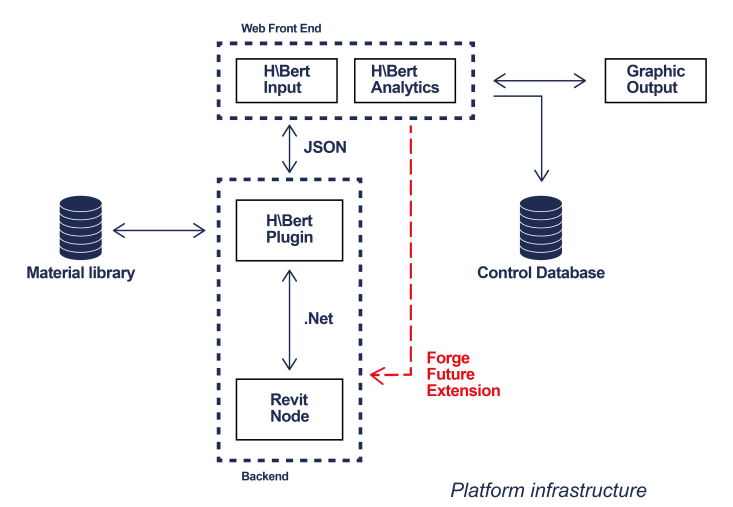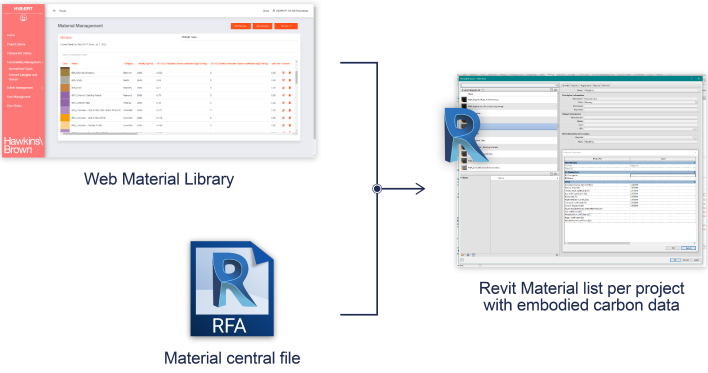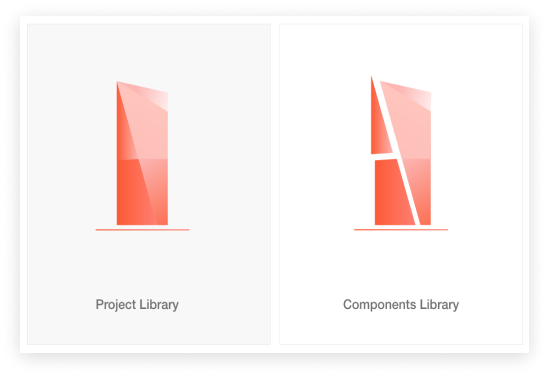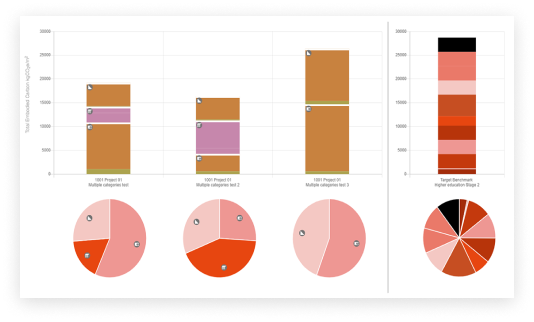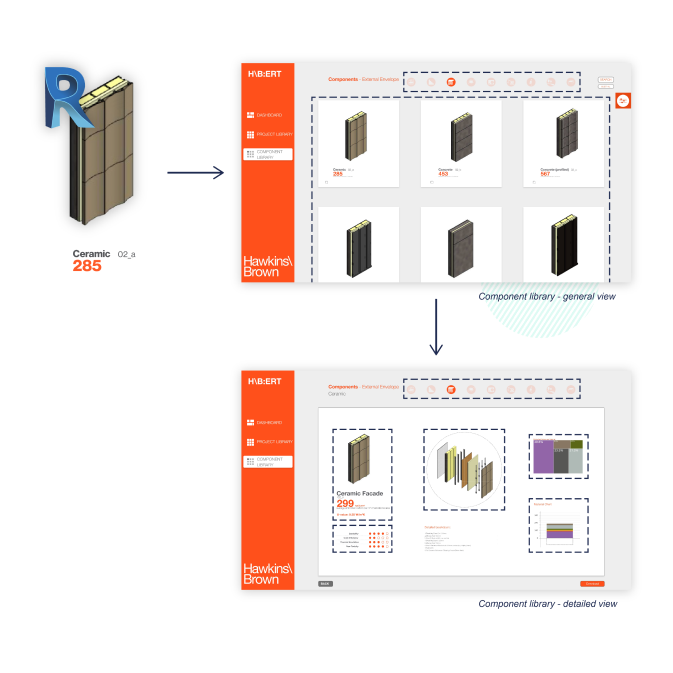Digital Emission Reduction Tool for Sustainable-Designed Buildings
Together with Hawkins\Brown, we built a whole lifecycle carbon footprint analysis tool that pulls data straight from Revit and a thoroughly researched material library database.
The digital solution helps one of the top architectural practices in the UK design buildings keeping in mind a sustainability first approach. It also consolidates their position as leaders in the industry.
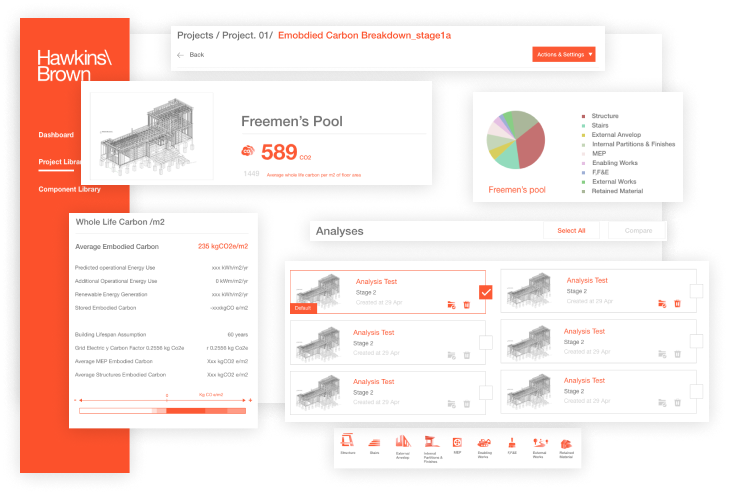

ABOUT THE CLIENT
Hawkins Brown is a top award-winning architecture practice in the UK with over 250 architects, urban designers, and researchers.
Since its establishment in 1988, it has designed and delivered innovative and socially sustainable buildings across multiple sectors.
https://www.hawkinsbrown.com/People are at the heart of everything they do. Thus they maintain a focus on bringing in fresh and collaborative approaches to their designs and processes.

Industry
AEC

Location
London, UK

Duration
1 year
Technologies used:

THE CHALLENGE
Hawkins\Brown is one of the architectural practices that challenge the traditional way of designing and always stay on top of the current needs and trends.
The vision at Hawkins\Brown is that new buildings must be designed to meet Net Zero Carbon targets, and they believe this should be done through Whole Life Carbon analysis. There has also been a growing trend in the industry to analyse, report, and reduce the embodied carbon emissions associated with the built environment.
With these in mind, Hawkins\Brown has created the H\B:ERT concept, intending to provide evidence-based creative solutions to reduce carbon emissions while enhancing the local environment and ensuring the well-being of building users.
OUR SOLUTION
With all this valuable data gathered during years of research, Hawkins\Brown wanted to enhance the capabilities of the database and needed a digital tool to leverage it to its full potential.
In 2019 Hawkins\Brown granted an internal research bursary to continue the development of H\B:ERT into a more complex tool that assesses a project’s whole life carbon impact.
Consultative approach
Due to our long-lasting collaboration with Hawkins\Brown, we were invited to be part of the H\B:ERT project as well, helping them from the feasibility stage to the development and long-term support.
During that year, the H\B:ERT requirements suffered a lot of internal changes. We started the discussions around developing a nationwide software to be used by multiple architectural practices to have a centralised database of buildings with their Whole Life Carbon analysis.
This looked to be a very ambitious project, so we decided to start with an internal tool first. It would allow us to test it out and see if the solution could be implemented at a larger scale later on.
During the software design phase, which we are calling the Pre-Development phase, Hawkins\Brown prepared mock-ups and set up all the calculations methodologies that the final system should take into considerations and use to provide the necessary information and reports.
After multiple meetings and analysis of the H\B:ERT concept, we have come up with the final modules for the system: a Global Material Library (Web and Revit), a Revit Plugin for 3D Models Integration, and a Web Dashboard for Analysis and Reporting.
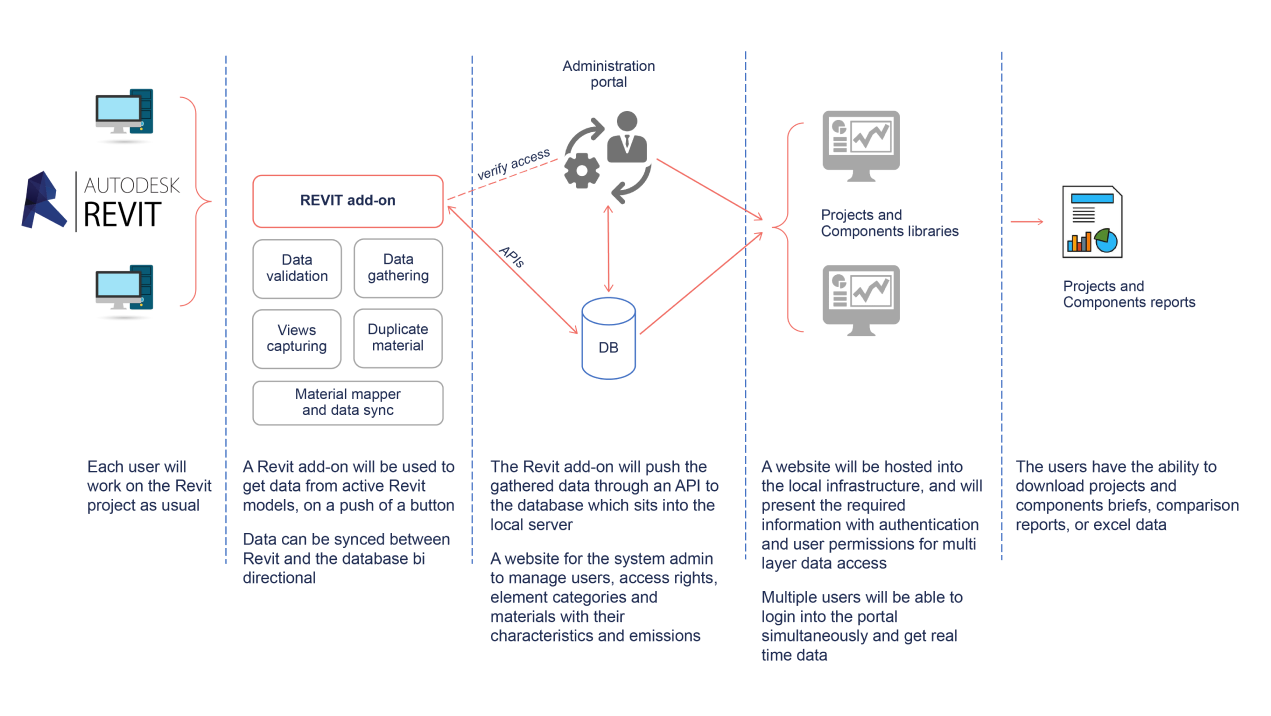
A 3-part Digital Platform
We built the Emission Reduction Tool from three different components:
The Material Library
This module is the spine of the entire app. This is where all the materials are stored, together with their Embodied Carbon parameters.
Hawkins\Brown are currently using the Circular Ecology ICE database, but any other databases could be referenced into the system. The company’s Sustainability team can manage data for each material, while the system stores data revisions for historical data visualisation.
We’ve linked the Web Material Library with a Revit Material Library, thus creating a 1:1 linking between the two. We have set up our Revit H\B:ERT plugin on top of Revit’s internal Material Editor, thus connecting the Web and Revit Material Library with each project Hawkins\Brown architects are working on and correcting some of Revit’s limitations when working with materials.
This plugin has managed to standardise the Hawkins\Brown internal use of materials throughout the entire practice.
The 1:1 linking created a seamless way of designing and made things easier since all the architects had access to the same material library. It also cut back on time needed to create individual material items.
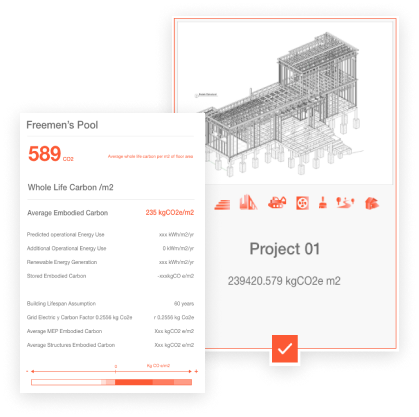
We have developed a Revit Plugin to read the entire model and gather the material’s volumes used throughout it for each of the building parts.
This information is then pushed to a web database and used in the Embodied Carbon calculations. Each project has its standard parameters such as lifespan, sector, building stage, components needed, and more. Together with the materials used and predefined calculations, these parameters give the overall carbon footprint of the building.
Revit Components Manipulation, Data Gathering, and Calculations
In order to gather the embodied carbon data from the architect’s models, each architect has to do the following steps:
associate each building component to a standardised H\B:ERT building part, like main structure, internal / external wall, etc
associate H\B:ERT materials to each component designed in their building
At any stage in the designing process, the architect can analyse the carbon impact their design decisions have on their project with the press of a button.
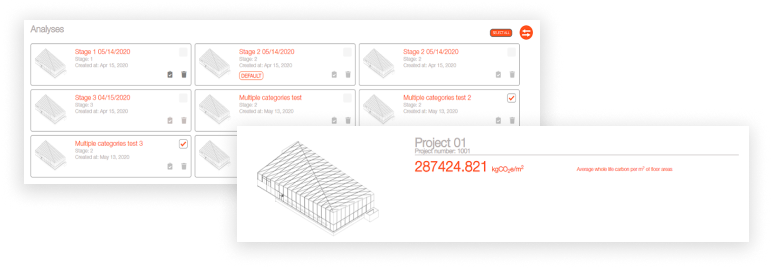
Web Visualisation
This is probably the most exciting part of the tool. Here an architect can view comprehensive reports about the designed building.
H\B:ERT dashboard is split into two main modules: Projects Library and Components Library.
The Projects Library offers complete data visualisation and Whole Life Carbon analysis for all client’s projects.
From project’s data, calculated statistics to graphics, analysis, and reports, H\B:ERT allows users to check the carbon impact of their design decisions. They are based on individual benchmarks for categories (roof, walls, etc.) and different designing stages.
Also, they can compare project stages, check historical data to track progress and see how buildings compare to each other.
The Components Library is a great tool for the Hawkins\Brown sustainability team to create reusable, low embodied carbon components to be used across the entire practice. This module has the same capabilities of benchmarking, data visualisation, and comparison as the Project Library.
While the platform is complex and can perform a wide variety of functions, the interface is clean, intuitive, and beautiful. All in all, making it suitable for the creative and intuitive eyes of designers and architects.
RESULTS

Over the years, developing over five digital projects with Hawkins\Brown, we have learned that they are an innovative architectural practice, always striving to improve their work, services offered to their client, and most importantly, the AEC Industry.
This latest phase of H\B:ERT’s development has won the practice the AJ100 Best Use of Technology Award, so H\B:ERT is an excellent example of how technology can help and improve our future.
The AEC community received the tool with enthusiasm, helping our partners consolidate their position as leaders in the British AEC sector once again.
Some key direct results H\B:ERT brought are:
allowed them to continuously review and make informed decisions for their approach to sustainable design across the practice
improved and standardized the design process for the entire practice while enhancing the local environment and ensuring the well-being of building users
Allow them to take proper steps to meet the Net Zero Carbon targets
Allow them to respond to current trends, and future client needs towards sustainability
Generate critical outputs and reports for several audits and awards: ISO 14001, award schemes including RIBA and Architects Journal, and Architects Declare and the RIBA 2030 Challenges
H\B:ERT is actively helping Hawkins\Brown achieve their vision, set new standards in the industry towards a greener environment, to build better, safer, and greener buildings.

Ben Robinson
Computational Design Specialist
Hawkins\Brown
Since 2017 we have built a great relationship with Fabrit Global and continued to work with them. We have recently appointed them to undertake a forth project with us.
From spending time at their office with the full team, it was evident that it's a team of talented individuals.
Got a similar idea?
Let’s talk about how you can implement it!
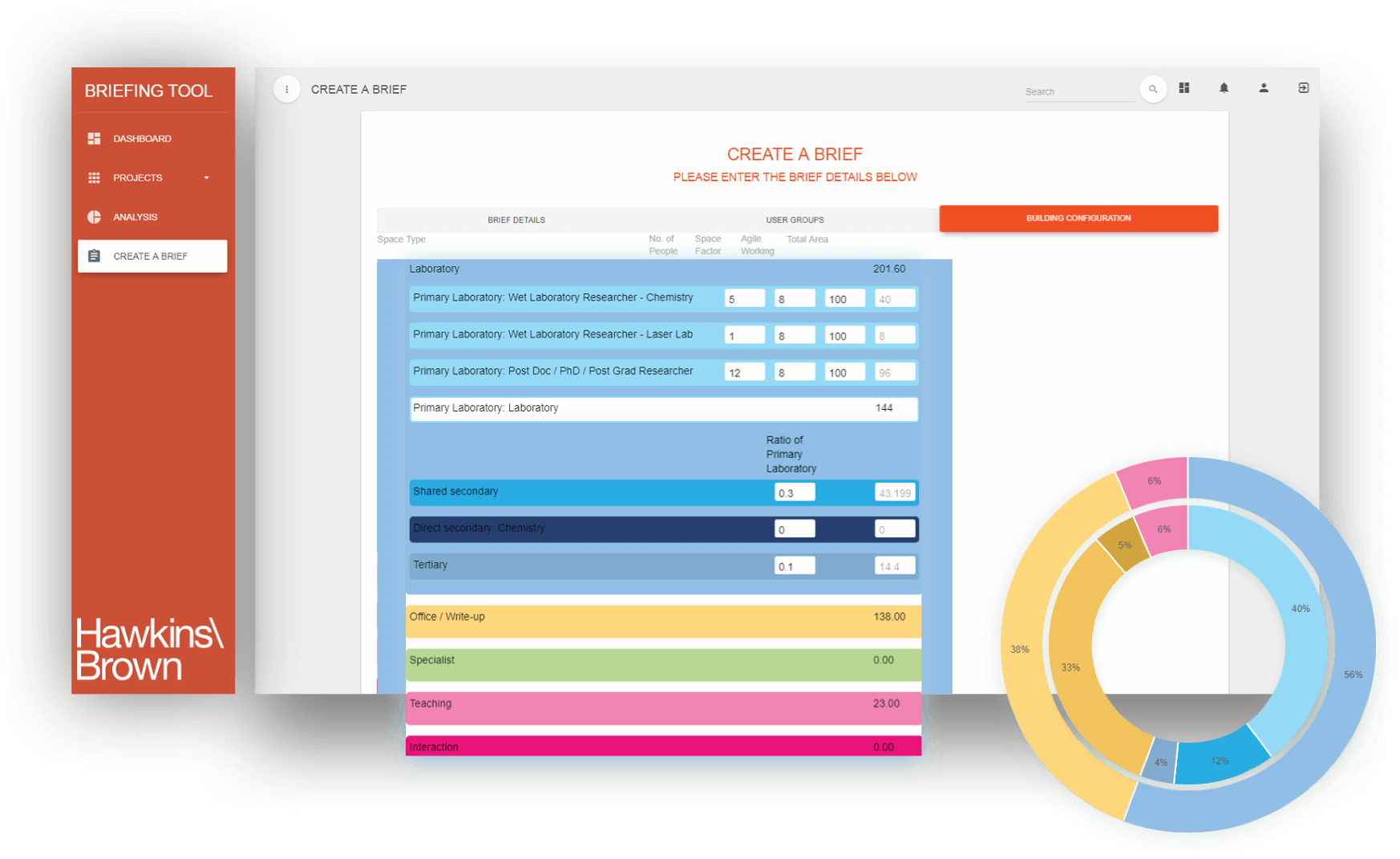
Innovative Automation of Building Design Simulations in Architecture
Automated briefing web platform, helping a London-based architecture practice gain significant competitive advantage by letting them visually represent area briefing data to their clients in an engaging and appealing way.
